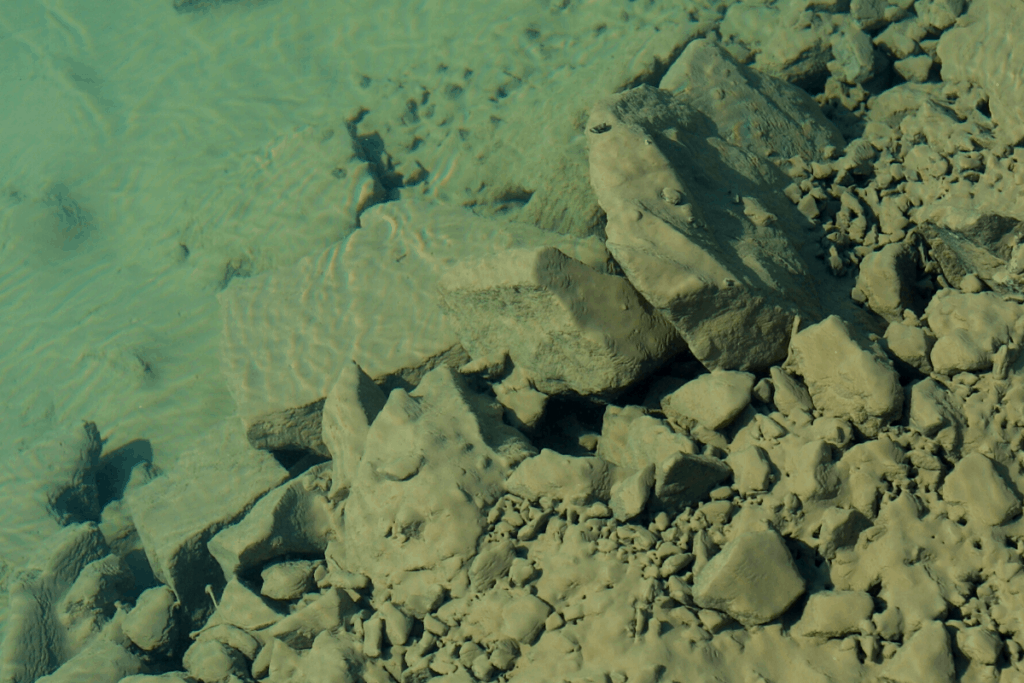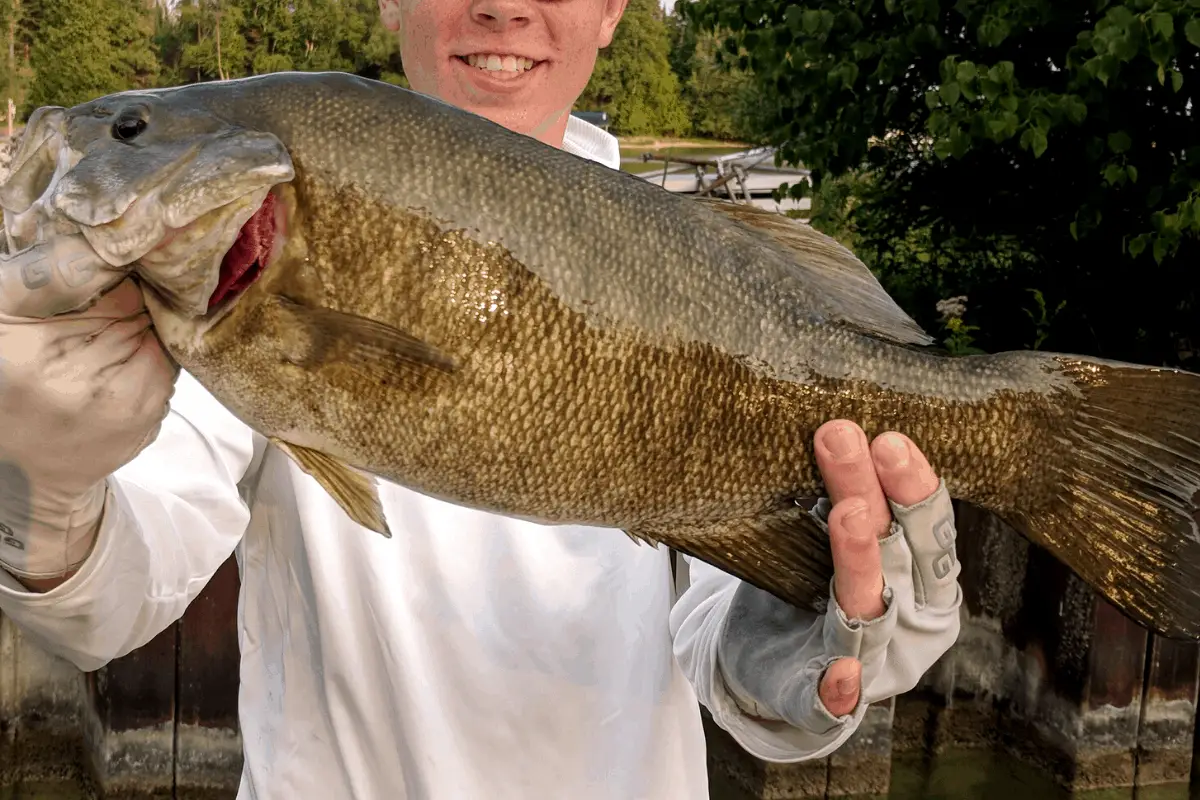Smallmouth bass seem to always be in a foul mood. It is this sour attitude that keeps them fighting all the way to the boat. Bass anglers love to catch them, yet they are decidedly different than their largemouth cousins.
To locate and catch more smallmouth bass anglers can use the following to their advantage. Smallmouth occupy cooler water, love the current and hard bottom composition, travel in packs, move around often, tend to love lures positioned in the water column, and can be finessed.
In this article, I will cover each of these topics and get the smallmouth bass fever going.
The Meanest of All The Bass
Smallmouth are perpetually in a foul mood.
They fight, jump, swim fast and feel like a bucking bronco on the end of the line. This gnarly disposition makes them a target of bass anglers whenever smallmouth might be in the area.
Professionals salivate at the opportunity to travel north during the tournament season and weigh heavy sacks of bronzebacks.
1. Target Cooler Water to Find Smallmouth
Smallmouth can be found in waters all over the country, but they prefer cooler temperatures.
On southern impoundments, this means they will often occupy deeper water than the largemouth in the same lake. As anglers travel to the northern regions smallmouth can be found shallower since the lakes never reach the temperatures found in the south.
Rivers are also a natural goldmine for smallies for the same reason. Rivers tend to maintain cooler temperatures because of the current.
For lake and reservoir anglers, finding smallmouth usually resorts in forgoing visible cover and using those bow-mounted electronics.
Cooler temperatures are also preferred by smallmouth during the spawn. Not only do they hit the beds earlier than largemouth, but they will spawn in deeper water too.
Changing a mindset to move away from the shoreline on a lake and focus on milder water temperatures can take some work. To find smallmouth though, the temperature is a critical part of the equation.
2. Current is Key for Positioning Smallmouth Bass
Smallmouth are infatuated with the current. Not only for the above-mentioned cooler temperatures, but they are strong swimmers that can nestle down to the bottom and wait for prey to drift by so they can obliterate it.
When thinking about current we always tend to imagine rivers teeming with brown bass. Lakes and reservoirs also have forms of current and to locate smallies we need to find these areas.
Large reservoirs pull water through the dam.
When this happens it will pull the smallmouth out to main lake points where the current washes over the structure. It may not be as obvious as river current, but the fish can sense it and will position in groups when the dam is generating.
On lakes with no natural current, the wind is a key ingredient in finding groups of smallmouth.
I have fished natural lakes in the northern part of the country many times. The best days for the smallmouth have almost always been when the wind is ripping into a shoreline. It stacks the fish and they aggressively feed.
I have also witnessed small streams trickling into a lake draw bronzebacks by the dozens. The clear water afforded me the chance to observe them from above. Those fiery fish hunkered down facing into the stream and pummeled anything that flowed to them – a total nightmare for any baitfish in the area.
Current does not look the same on every body of water, but focus on places where the wind, boat wakes, or natural flow is washing across structure and you are already putting the odds in your favor to find smallmouth bass.

3. Smallmouth Bass Love Hard Bottom Composition
Smallmouth gravitate to areas with a hard bottom.
This could be boulders, chunk rock, pea gravel, shell beds, or sand. They will do their best to avoid muck and muddy bottoms.
In rivers systems with lots of thick vegetation, smallmouth will hold on open and rocky areas within the weeds. They may slip into the green stuff if spooked, but will settle back onto the rock when comfortable.
In a lake with lots of hard bottom areas, anglers will need to decipher what type of structure they prefer on that day. Transition zones between two different types of rock are excellent locations to start investigating.
Lakes and rivers that primarily have a soft bottom will force the smallmouth to hang on cover that offers a hard composition to it. This may be a single rock, a piece of concrete, or in some situations, it will even be wood.
It doesn’t take a very large piece of hard cover to hold fish. That small, unobtrusive rock may have a giant lurking near it.
4. Smallmouth Travel in Packs
There have been singular occasions where I catch one smallmouth from a spot – but that is rare.
When one is found you can bet there is something down there that is holding others as well.
I’ll never forget one outing on the Mississippi River during the pre-spawn. The smallmouth were just moving into areas off the main river and holding on sandy points. We located a school and used ultra-shallow squarebill crankbaits to pound through the shallow, sandy point.
We caught so many three-pound smallmouth that morning the finish actually wore off the lure. By the time the feeding frenzy stopped my adrenaline was going into overdrive.
Those are the types of moments that smallmouth afford an angler that has located a pack.
When that first fish hits, the school may be whipped up into a mad rage and demolish anything that resembles food. After locating one, stick around and assume there are more in the area.
5. Smallmouth Move – Often
It can be maddening how far and often smallmouth will travel.
When winter is approaching they can migrate a tremendous distance heading towards deeper water. One scientific study tracked a smallmouth twenty-three miles before it settled in for the cold season.
Why do they move?
Two reasons.
The food has moved and/or the weather has changed.
If smallies are actively feeding on baitfish, they will follow that food all over a lake or river. When this happens electronics are a key component to relocating them.
If this bait is near the top of the water column, observing the birds is another great way to find them. Flocks of gulls may be seen circling above the water and you can bet they have their eye on a snack.
The smallmouth are probably there too.
Weather is the other major factor in repositioning smallies – especially the wind.
There may be a huge school on a boulder one day and gone the next because the wind shifted directions. The wind-generated current can drive fish from one shoreline to the opposite side. Keep looking for the bait and where the wind is pushing and two major ingredients for finding smallmouth are accounted for.
If there is not food in the area, the smallies will not be there. Even if it is the most perfect setting. The only exception to this is during the spawn.
6. Smallmouth Love Lures up in the Water Column
Yes, smallmouth love crawfish.
Yes, they will hunt the bottom looking and feeding on this favorite food source.
With that said, I have caught more smallmouth and get better bites when the lures are up off the bottom.
I’m not sure if it is because of a smaller jaw or what the actual biological reason is, but when a lure is up off the bottom the rod is likely to get ripped from a fierce strike.
Drop shot rigs, hard and soft jerkbaits, spinnerbaits, and swimbaits get obliterated. In fact, drop-shotting smallmouth might just be the number one way these fish are caught.
If you are sure there are smallies in the area and are having a difficult time getting a bite with a lure on the bottom, try something up in the water column. Even presenting a lure just a few inches above the bottom can make the adjustment needed to get that fish to commit.
I catch a lot of smallies on a wacky rig, but the majority of the strikes come on the initial fall. Keep adjusting and trying different presentations until you find what they prefer that day.
7. Finesse Lures Work Really Well
As mentioned above with the drop shot rig, finesse presentations are excellent tools at coaxing smallmouth to bite.
Smallies are primarily sight feeders. They like clear water, they prefer current and open rocky bottoms. All of these situations are key to seeing prey.
Being a sight feeder also means that a natural presentation is often the difference between a bite or zero reaction.
Light line and sharp light-wire hooks with small lures can save a day when the traditional reaction lures fail to produce.
When things are tough, smallmouth do respond to finesse tactics.
Power Drop Shot
How is this different than a regular drop shot?
A power drop shot uses a larger weight. That’s it.
Why?
We mentioned earlier that smallmouth actively hunt for food, unlike a largemouth that traditionally wait for something to pass by.
A heavier drop shot weight means it can be fished faster while searching for smallmouth. Cast the lure out. Shake it a time or two, then reel it back in and repeat the process. Keep moving.
If there are smallmouth in the area they will likely hit it.
A power drop shot is used for searching, just like an angler would use something like a jerkbait or spinnerbait to locate fish.
I use a weight that is up to a ½ oz in size when fishing a drop shot rig like this. The lure sinks quick, often causing reaction bites on the fall. After it gets to the bottom a twitch or two will let you know if they are there.
Final Thoughts
Smallmouth are a blast. They are a favorite from coast-to-coast and are aggressive feeders.
Keep these seven tips in mind and you are well on the way to some great days on the water chasing these football-shaped predators.
- Locate Cooler Water
- Find Current
- Identify Hard Bottom Composition
- Realize Smallmouth Travel in Packs and Hunt that Way
- Smallmouth Move Often
- They Punish Lures Up in the Water Column
- Finesse Presentations Work Well
Good luck out there and be safe. Remember to encourage someone today, you never know how you might change their life forever.
Isaiah 6:8

